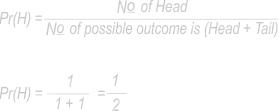Lesson Plan for Teachers
Lesson Note for Junior Secondary
Theme: Probability
Topic: Probability
Sub Topic: Range of Probability measure 0 ≤ P(x) ≤ 1
Date: dd/mm/yyyy
Class: J.S.S 2
Duration: 35 Minutes
No of Learners: 30
Learning Objectives:
By the end of the lesson learners should be able to:Say what probability is.
Write the general formula for probability(Pr).
Determine the range of probability measures (Solve problems on probability).
Probability is the study of possible occurrences in everyday life. When we say possible occurrences, we are referring to possible events such as rainfalls, sunshine, winning a football match, lossing a football match, eating, going to the library etc.

Example.
If we toss a fair die, what is the probability that it will show 3?
Solution.
Probability of three
Number of required outcome = { 3 } is One(1) Number of possible outcome = { 1, 2, 3, 4, 5, 6 } is Six(6)
ꓽ∙ Pr(3) = 1/6
Rationale:
Probability is applicable in our daily life in such areas as weather prediction, predicting the risks of new medical treatments, predicting results in sports, among many areas. Moreover, companies and business people can use probability to predict the chances that their sales will go up by a certain per cent in a given year. Probability enables you to make decisions in situations where there are observable patterns with some degree of uncertainty.
Prerequisite/ Previous knowledge:
Students have learnt Fractions, Decimals, Algebra, Statistics 1.
Learning Materials:
Computing device, manila paper, coins.
Reference Materials:
New General Mathematics for Junior Secondary Schools Books 1 By Pearson
Lesson Development:
| STAGE | TEACHER'S ACTIVITY | LEARNER'S ACTIVITY | LEARNING POINTS |
|---|---|---|---|
| INTRODUCTION full class session (5mins) |
Comparing fractions and decimals 1/4 of 3 |
Pupils respond to the teacher's question. 1/4 x 3 = 3/4 |
Multiplication of fraction, Division of fractions, Conversion of decimals to fractions and vice versa. Revision of the previous knowledge on fractions and decimals. |
| STEP 1 2mins. Development |
Teacher to provide learners with coins and allow them to identify the items. | Pupils identify the apparatus as coins | Being able to identify the apparatus. |
| STEP 2 5mins. |
The teacher asks learners to toss coins and progressively compare the cumulative fractions of Head(H) or Tail(T) at a tally of 10. | Learners toss coins and progressively compare the cumulative fractions of Head(H) or Tail(T) at a tally of 10.

|
Determine the probability measure of Head and Tail of fair toss coin at entries of 10. |
| EVALUATION 7mins |
The teacher asked the pupils questions.
|
Pupils respond to teachers questions.
|
Asking the learners questions to assess the achievement of the set objectives. |
| CONCLUSION 3mins |
A coin is tossed once for two teams playing a football match. What is the probability that the team with the head starts the game? HINT: there are only two outcomes in a coin namely: 1 for head and 1 for a tail. |
The students respond to the teacher's question.
|
The probability range 0 ≤ P(x) ≤ 1 |
| ASSIGNMENT | Give them other problems to solve.
|
Pupils solve other problems. | Improving their level of understanding on the probability range 0 ≤ P(x) ≤ 1. |
